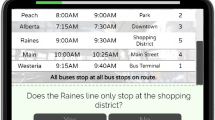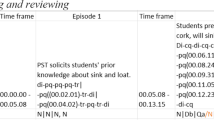Abstract
The goal of this study is to identify the multiple ways in which instructors take advantage of a feature designed into university textbooks that seeks to invite students to get acquainted with the content prior to attending the class in which such content will be discussed. We present an analysis of teacher instrumentation of this feature, which we call questioning devices, using data from 15 instructors who taught calculus, linear algebra, or abstract algebra over one semester. The instructors taught at 14 different universities in the United States. We identified four utilization schemes of the questioning devices in which instructors: completed questioning devices for pre-planning, required students to complete the questioning devices for the purpose of lesson planning, used the questioning devices for the purpose of instruction, and required students complete the questioning devices for the purpose of assessment. These schemes are supported by various operational invariants related to self-perception as competent instructors and implicit theories of teaching and learning. The identified utilization schemes inform textbook developers and author-designers, making them aware of whether these features fulfill their design purposes, and possibly think about changes that might be needed to support instructors in achieving their instructional goals and improve learning. We suggest some further areas of inquiry.




Similar content being viewed by others
Notes
As for the abstract algebra textbook, Beezer who designed the reading questions, indicates that “collecting responses to the Reading Questions prior to covering material in class will require students to learn how to read the material.” (Rob Beezer, personal communication, December 29, 2020).
There was insufficient evidence for T17 and T24 to identify a utilization scheme.
We maintained participants’ choice of wording and capitalization in all their quotes.
References
Axtell, M., & Turner, W. (2007). Examining the effectiveness of reading questions in introductory college mathematics courses. In J. Fanghanel & D. Warren (Eds.), International conference on the scholarship of teaching and learning (pp. 205–210). CEAP.
Beezer, R. A. (2019). First course in linear algebra. Congruent Press.
Benn, R. (1997). Reading, writing, and talking about mathematics. In D. Coben (Ed.), Proceedings of the third international conference of adults learning maths (pp. 24–29). Goldsmiths College, University of London.
Boelkins, M. (2019). Active Calculus. CreateSpace Independent Publishing Platform.
Chevallard, Y. (2003). Approche anthropologique du rapport au savoir et didactique des mathématiques [Anthropological approach to the relationship to knowledge and didactics of mathematics]. In S. Maury & M. Caillot (Eds.), Rapport au savoir et didactiques [The relationship between knowledge and didactics] (pp. 81–104). Fabert.
Choppin, J., Carson, C., Borys, Z., Cerosaletti, C., & Gillis, R. (2014). A typology for analyzing digital curricula in mathematics education. International Journal of Education in Mathematics, Science and Technology, 2(1), 11–25.
Clark, L. M., DePiper, J. N., Frank, T. J., Nishio, M., Campbell, P. F., Smith, T. M., & Choi, Y. (2014). Teacher characteristics associated with mathematics teachers’ beliefs and awareness of their students’ mathematical dispositions. Journal for Research in Mathematics Education, 45(2), 246–284.
Clark-Wilson, A. (2010). Emergent pedagogies and the changing role of the teacher in the TI-Nspire Navigator-networked mathematics classroom. ZDM Mathematics Education, 42(7), 747–761.
DeJarnette, A. F., Wilke, E., & Hord, C. (2020). Categorizing mathematics teachers’ questioning: The demands and contributions of teachers’ questions. International Journal of Educational Research, 104, 101690. https://doi.org/10.1016/j.ijer.2020.101690
Ellis, J. (2015). Three models of graduate student teaching preparation and development. In D. M. Bressoud, V. Mesa, & C. L. Rasmussen (Eds.), Insights and recommendations from the MAA National Study of College Calculus (pp. 117–122). MAA Press.
Gerami, S., Leckrone, L., & Mesa, V. (2020). Exploring instructor questions in community college algebra classrooms and its connections to instructor knowledge and student outcomes. MathAMATYC Educator, 11(3), 34–43.
González-Martín, A. S., Nardi, E., & Biza, I. (2018). From resource to document: Scaffolding content and organising student learning in teachers’ documentation work on the teaching of series. Educational Studies in Mathematics, 98(3), 231–252.
Gueudet, G. (2017). University teachers’ resources systems and documents. International Journal of Research in Undergraduate Mathematics Education, 3(1), 198–224.
Gueudet, G., & Pepin, B. (2018). Didactic contract at the beginning of university: A focus on resources and their use. International Journal of Research in Undergraduate Mathematics Education, 4(1), 56–73.
Gueudet, G., & Trouche, L. (2009). Towards new documentation systems for mathematics teachers? Educational Studies in Mathematics, 71(3), 199–218.
Inglis, M., & Alcock, L. (2012). Expert and novice approaches to reading mathematical proofs. Journal for Research in Mathematics Education, 43(4), 358–390.
Judson, T. (2019). Abstract algebra: Theory and applications. Orthogonal Publishing L3C.
LoTi. (2016). LoTi Digital Age Survey for Teachers-20th anniversary edition. Retrieved from https://conference.iste.org/uploads/ISTE2016/HANDOUTS/KEY_100410573/LoTiDigitalAgeSurveyTeachers20th.pdf. Accessed 5 Dec 2018.
Love, E., & Pimm, D. (1996). 'This is so’: A text on texts. In A. J. Bishop, K. Clements, C. Keitel, J. Kilpatrick, & C. Laborde (Eds.), International handbook of mathematics education, vol 1 (pp. 371–409). Kluwer.
Maida, P. (1995). Reading and note-taking prior to instruction. The MathematicsTeacher, 88, 470–473.
Mason, J. (2020). Questioning in mathematics education. In S. Lerman (Ed.), Encyclopedia of mathematics education (pp. 705–711). Springer International Publishing.
Mesa, V., Mali, A., & Castro, E. (2019). University student use of dynamic textbooks: An exploratory analysis. Paper presented at the Eleventh Congress of the European Society of Research in Mathematics Education (CERME), Utrecht, The Netherlands.
Mesa, V. (2010). Strategies for controlling the work in mathematics textbooks for introductory calculus. Research in Collegiate Mathematics Education, 16, 235–265.
Mesa, V., & Griffiths, B. (2012). Textbook mediation of teaching: An example from tertiary mathematics instructors. Educational Studies in Mathematics, 79(1), 85–107.
O’Halloran, K. L., Beezer, R. A., & Farmer, D. W. (2018). A new generation of mathematics textbook research and development. ZDM Mathematics Education, 50(5), 863–879.
Paoletti, T., Krupnik, V., Papadopoulos, D., Olsen, J., Fukawa-Connelly, T., & Weber, K. (2018). Teacher questioning and invitations to participate in advanced mathematics lectures. Educational Studies in Mathematics, 98(1), 1–17.
Rabardel, P. (2002). People and technology: a cognitive approach to contemporary instruments. Université Paris 8.
Rabardel, P., & Waern, Y. (2003). From artefact to instrument. Interacting with Computers, 15(5), 641–645.
Rezat, S. (2013). The textbook-in-use: Students’ utilization schemes of mathematics textbooks related to self-regulated practicing. ZDM Mathematics Education, 45, 659–670.
Rubenstein, R. (1992). Improving students’ reading with quizzes. The Mathematics Teacher, 85, 634–635.
Ruthven, K. (2018). Instructional activity and student interaction with digital resources. Research on mathematics textbooks and teachers’ resources (pp. 261–275). Springer.
Ruthven, K., Deaney, R., & Hennessy, S. (2009). Using graphing software to teach about algebraic forms: A study of technology-supported practice in secondary-school mathematics. Educational Studies in Mathematics, 71(3), 279–297.
Ruthven, K., Hennessy, S., & Deaney, R. (2008). Constructions of dynamic geometry: A study of the interpretative flexibility of educational software in classroom practice. Computers and Education, 51(1), 297–331.
Shepherd, M. D., Selden, A., & Selden, J. (2010). University students’ reading of their first-year mathematics textbooks. Mathematical Thinking and Learning, 14(3), 226–256.
Tallman, M. A., Carlson, M. P., Bressoud, D. M., & Pearson, M. (2016). A characterization of calculus I final exams in US colleges and universities. International Journal of Research in Undergraduate Mathematics Education, 2(1), 105–133.
Trouche, L. (2020). Instrumentation in mathematics education. In S. Lerman (Ed.), Encyclopedia of mathematics education (pp. 404–412). Springer International Publishing.
Trouche, L., Gueudet, G., & Pepin, B. (2020). Documentational approach to didactics. In S. Lerman (Ed.), Encyclopedia of mathematics education (pp. 237–247). Springer International Publishing.
van Dormolen, J. (1986). Textual analysis. In B. Christiansen, A. G. Howson, & M. Otte (Eds.), Perspectives in mathematics education (pp. 141–172). Reidel.
Vergnaud, G. (1998). Towards a cognitive theory of practice. In A. Sierpinska & J. Kilpatrick (Eds.), Mathematics education as a research domain: A search for identity (pp. 227–240). Kluwer.
Vérillon, P., & Rabardel, P. (1995). Cognition and artifacts: A contribution to the study of thought in relation to instrumented activity. European Journal of Psychology of Education, 10, 77–101.
Viirman, O. (2015). Explanation, motivation and question posing routines in university mathematics teachers’ pedagogical discourse: A commognitive analysis. International Journal of Mathematical Education in Science and Technology, 46(8), 1165–1181.
Weber, K., Brophy, A., & Lin, K. (2008). Learning advanced mathematical concepts by reading text. Paper presented at the Conference on Research in Undergraduate Mathematics Education, San Diego, CA.
Weinberg, A., & Wiesner, E. (2011). Understanding mathematics textbooks through reader-oriented theory. Educational Studies in Mathematics, 76(1), 49–63.
White, N. J., & Mesa, V. (2014). Describing cognitive orientation of calculus I tasks across different types of coursework. ZDM Mathematics Education, 46(4), 675–690. https://doi.org/10.1007/s1185801405889
Acknowledgements
Funding for this work has been provided by the National Science Foundation through Awards IUSE 1624634, 1821509. Any opinions, findings, and conclusions or recommendations expressed in this material are those of the authors and do not necessarily reflect the views of the National Science Foundation.
Author information
Authors and Affiliations
Corresponding author
Additional information
Publisher's Note
Springer Nature remains neutral with regard to jurisdictional claims in published maps and institutional affiliations.
Rights and permissions
About this article
Cite this article
Mesa, V., Ma, Y., Quiroz, C. et al. University instructors’ use of questioning devices in mathematics textbooks: an instrumental approach. ZDM Mathematics Education 53, 1299–1311 (2021). https://doi.org/10.1007/s11858-021-01296-5
Accepted:
Published:
Issue Date:
DOI: https://doi.org/10.1007/s11858-021-01296-5




